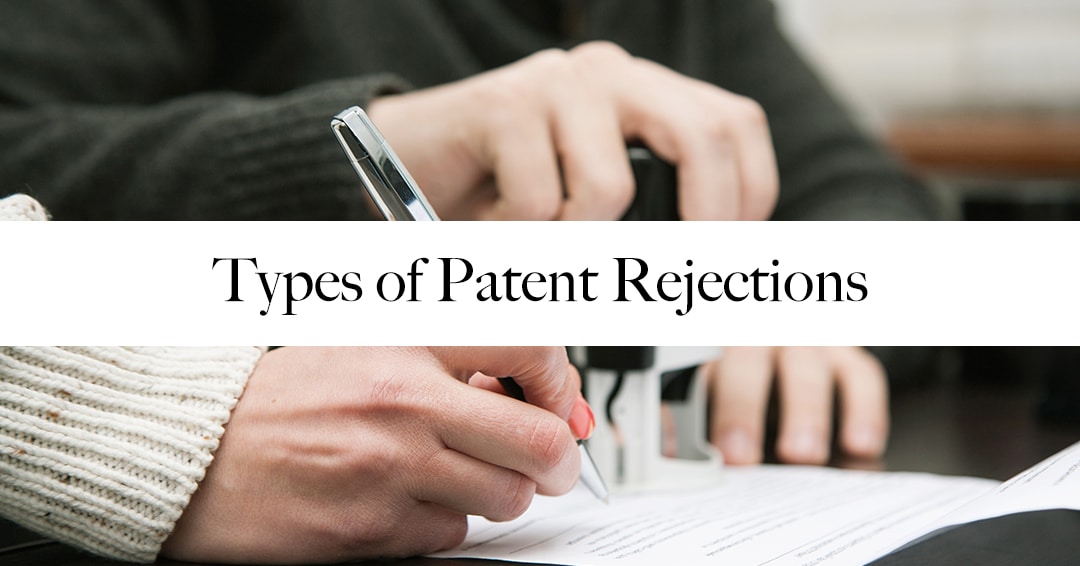Originally posted on September 15, 2023 @ 11:37 pm
Patents serve as a **protection** for your smart inventions and drive new innovations. However, embarking on the patent application process can feel like traversing a maze, intimidating even the bravest individuals. One significant challenge inventors often face is having their patent application denied.
So, in this article, we will explore the different types of patent rejections, provide an understanding of each type, and highlight strategies for responding to them effectively. However, before delving into the details, let’s get a clear understanding of what a patent rejection is.
What are Patent Rejections?
When a patent application is submitted, it goes through a rigorous examination process where a patent examiner reviews the application to ensure that it meets all the necessary criteria for patentability, which includes assessing whether the invention is novel, non-obvious, and useful.
When the patent doesn’t meet the requirements, a notification is sent out from the United States Patent and Trademark Office, indicating which requirements have not been met by the relevant patent regulations, giving the applicant a chance to respond.
To further understand how patent rejections work, let’s take a look at the five most common types of patent rejections and their meanings, so you can gain a clearer understanding of the next steps to take in your patent process.
The 5 Most Common Types of Patent Rejection
When you receive a patent rejection, you will either get a non-final or a final rejection. So, to further understand how patent rejections work, let’s take a closer look at these types of patent rejections and why you could receive them:
| Type of Rejection | Meaning | Possible Reasons for Rejection |
| Non-final | They are initial rejections that allow the applicant an opportunity to overcome the issues raised by the examiner, by strengthening the weaknesses in their original application and resending it. | It is proven obvious. |
| There is already a similar patent. | ||
| A lack of disclosure in regards to the information of the invention. | ||
| Final | They are typically issued when the applicant’s response to a non-final rejection fails to convince the examiner of its patentability, in which case you can file for an appeal or request continued examination. | They determined non-patentability. |
| The invention is flawed. | ||
| There has been a misunderstanding, in which case you could appeal. | ||
| Office Action | They are issued by the patent examiner through a written communication known as an office action and highlight the deficiencies in the application to provide an opportunity for the applicant to respond and overcome the stated objections. | Prior art, which refers to any existing knowledge or evidence that renders the invention obvious. |
| The lack of novelty or non-obviousness, which means the invention is not new or does not innovate compared to what is already known in the field. | ||
| Restriction Requirement | These are handed out when a patent examiner believes that an application encompasses multiple inventions and requires the applicant to elect a specific invention for examination, so each invention receives proper examination and consideration. | The examiner’s belief that the application contains distinct and separate inventions. |
| They are distinct aspects of the same invention, which calls for divisional applications. | ||
| Statutory Subject Matter Rejection | Occurs when the examiner determines that the invention does not fall under the statutory subject matter categories defined by the patent laws. | It breaks process regulations. |
| They break machine regulations. | ||
| They break manufacturing regulations. |
Trust us when we tell you that you don’t want to leave a non-final patent rejection unanswered, as it would be the same as giving up a quarter of a mile before the finish line. So let’s get into why it is vital for you to respond to patent rejections.
The Importance of Responding to Patent Rejections
Responding to patent rejections is crucial for securing patent protection for your innovation. By effectively addressing the concerns raised by the patent examiner, applicants can increase their likelihood of obtaining a granted patent.
Failing to respond to rejections can result in the abandonment of the application, limiting the protection of the invention. So, thoroughly analyze the examiner’s arguments to understand the basis for the rejection and craft a persuasive response, which will require:
- Clear and concise writing.
- Strong legal arguments.
- And improvement in the technical aspects.
But now that we have gotten into why it is vital to respond to patent rejections, let’s take a deeper dive into how to respond to each type of patent rejection so you can have a better chance of getting approved.
How to Respond to Patent Rejections
The process of responding to a patent rejection varies widely between each type of rejection. So to better understand how to respond, let’s take a closer look at the step-by-step process of responding to each type of patent rejection:
Responding to Non-Final Rejections
If you have received a non-final rejection, it is quite easy to overcome. However, to make things easier on you, let’s take a further look into how you can respond to a non-final rejection:
- Analyze the examiner’s objections, which will help you identify potential weaknesses in the application, allowing you to craft a compelling argument.
- Consult with a patent attorney who can provide assistance in identifying relevant case precedents and developing persuasive arguments to overcome the rejections.
- Revise the language of the claims to more precisely define the scope of the invention or to differentiate it from the prior art that exists.
- Submit new experimental data, expert opinions, or other forms of evidence to help strengthen the arguments and demonstrate the patentability of the invention.
By carefully analyzing the non-final rejections and crafting a well-reasoned and persuasive response, applicants can increase their chances of overcoming the rejections and obtaining a valuable patent for their invention.
Responding to Final Rejections
After receiving a final rejection, applicants have several options, each with its pros and cons. So let’s further explore them to see which one best suits your needs:
| Strategy | Pros | Cons |
| Appeal the decision to the Patent Trial and Appeal Board, which is a formal process that involves presenting arguments and evidence to the panel. | It allows you to have your case reviewed by a different set of eyes and potentially obtain a favorable outcome. | It can be costly and time consuming. |
| Request continued examination, which involves filing a request with the examiner to reopen prosecution and consider further amendments or arguments. | They can be useful when new arguments have been developed that could potentially overcome the examiner’s concerns. | Consider the timing and potential costs associated with this option. |
| Make amendments and arguments to address the examiner’s concerns. | It allows for a more immediate response and can be cost-effective. | It has a higher risk of further rejection. |
By carefully analyzing the examiner’s reasoning and crafting persuasive arguments, applicants may be able to convince the examiner to reconsider their decision. Remember, seeking professional advice from a patent attorney can be invaluable in increasing the chances of a successful outcome.
Responding to Office Action Rejections
If you have received an office action rejection, it could require a more meticulous intervention to get approved. However, to make things easier on you, let’s take a look at how to respond to an office action rejection:
- Analyze the examiner’s objections in order to create a well-crafted response that caters to the examiner’s concerns.
- Address each objection methodically by citing relevant prior art, providing detailed arguments, and amending the claims.
- Collaborate with a patent professional, which can enhance the effectiveness of the response given their extensive experience in dealing with office action rejections.
- Ensure that all the legal requirements are met and the best possible arguments are presented.
It is important to note that overcoming office action rejections may require multiple rounds of communication with the patent examiner, which allows you to address the examiner’s concerns and provide additional evidence to support the patentability of your invention.
Responding to Restriction Requirement Rejections
If you have received a restriction requirement rejection, the examiner may argue that the claims are directed to distinct inventions and require restriction, which makes responding to them harder. So let’s take a deeper look into how to respond to a restriction requirement rejection:
- Understand the reasons behind rejection by analyzing the examiner’s claims to determine if the rejection is justified and help you formulate a strong response.
- Once you have understood the differences or possible multiple inventions in your original application, select a single invention to focus on and justify the selection.
- Demonstrate the unity of invention and the distinctness of the selected claims by explaining why they are directed at a single invention and how they are interconnected.
- Highlight the common features or elements shared by the claims and provide arguments or supporting evidence to show that the claims are not directed at separate inventions.
By understanding the reasons behind these rejections and responding effectively, you can increase their chances of obtaining a favorable outcome. If the examiner’s position is deemed unjustified, you can challenge the rejection through an appeal or other appropriate means.
Responding to Statutory Subject Matter Rejections
When addressing statutory subject matter rejections, focus on clearly establishing the patent-eligibility of the invention by providing arguments and evidence demonstrating that the claimed invention falls within the defined statutory categories.
You may want to collaborate with a patent professional, as they can greatly enhance your chances of success in overcoming these rejections. So let’s take a look at when it may be best to call in the pros.
When to Seek Professional Help for Patent Rejections
It is important to recognize that the patent application process can be complex, and tackling rejections alone may not yield optimal results. Seek the assistance of a patent attorney with expertise in patent rejections when you don’t understand how to respond, which can significantly improve the chances of obtaining patent protection for your innovation.
Don’t Let Patent Rejection Stop You
By understanding the types of patent rejections, their characteristics, and the appropriate response strategies, applicants can navigate the patent application process with confidence. Successful responses to patent rejections can lead to the issuance of a granted patent, providing inventors and innovators with the necessary legal protection to fully capitalize on their creations.






